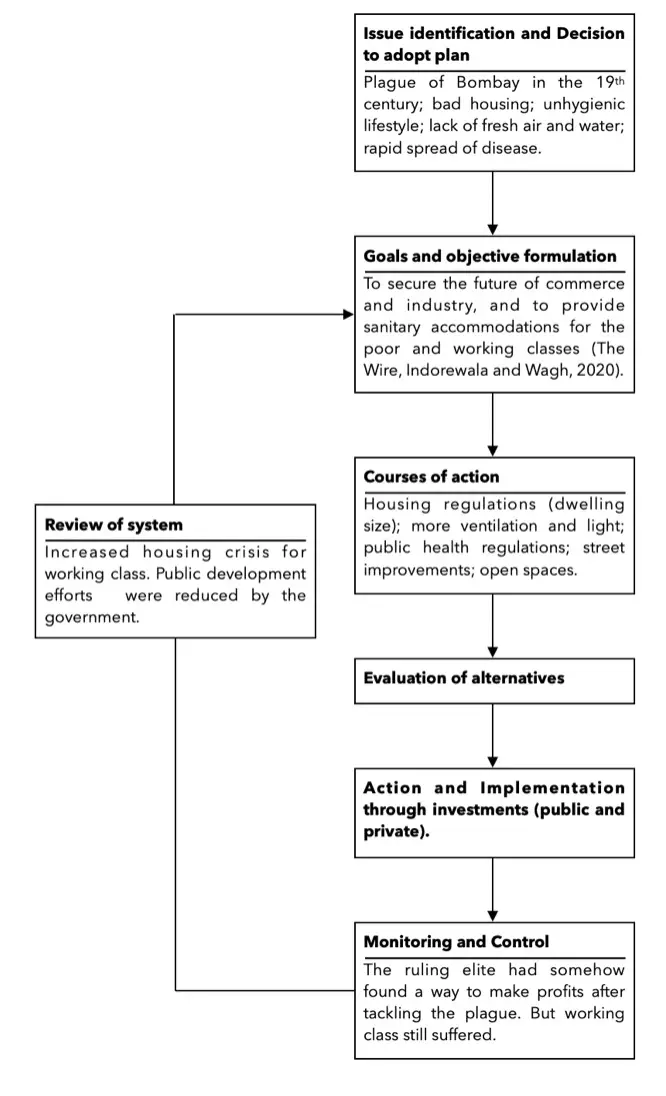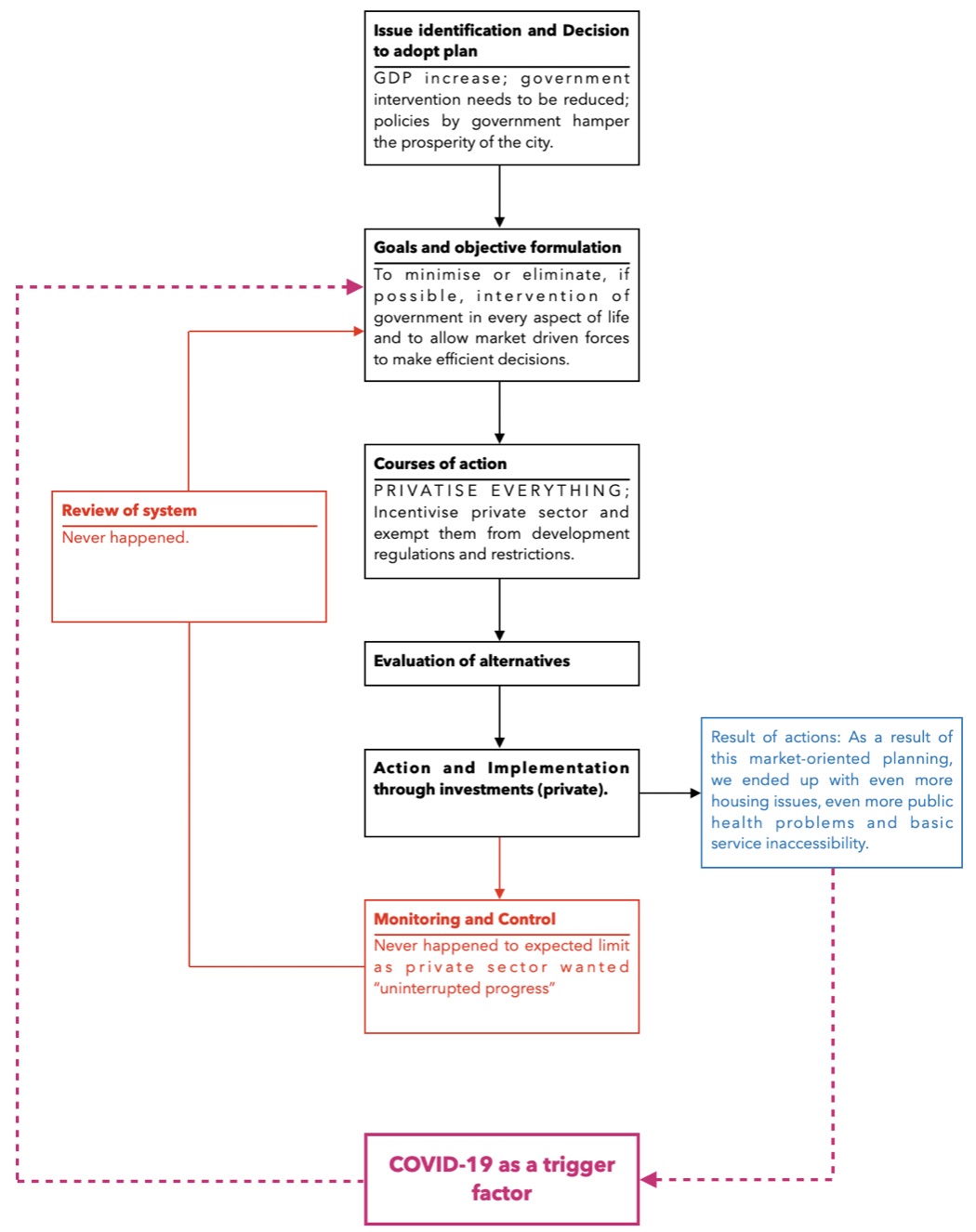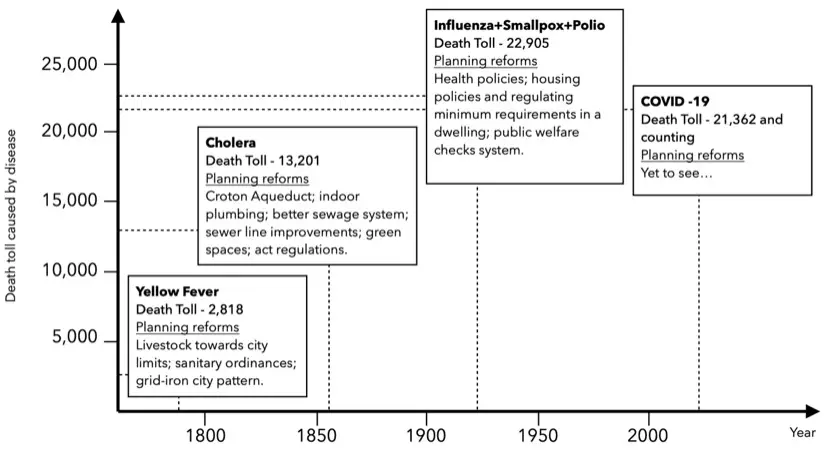This is a five-part series that revolves around understanding the current situation of Indian cities during the COVID-19 outbreak, and how resilience can be applied within our cities as a response to the resolutions of ‘social-distancing’. In this second part, we shall discuss about how Bombay and New York responded to disease outbreaks.
This post was created by the author during his internship period and is also available at Housing and Urban Development Corporation Ltd (HUDCO), New Delhi.
Previous in Series: Applying resilience to Indian city plans against pandemics (Part 1 of 5)
Next in Series: Pandemic hotspots: Result of urban density or urban form? (Part 3 of 5)
History of planning in Bombay city
The question that arises in our heads is “Have we not learned from our mistakes?”. Let us explore deeper into this question by using the rational planning model (inspired by the systems view of planning approach by Brian McLoughlin) and by taking the example of planning in Bombay from the 19th century.
In between the years 1896 and 1899, the city of Bombay succumbed to the bubonic plague. The city had poor, overcrowded, and devastated neighborhoods. The lives of humans and businesses were at stake. Streets and houses were completely in unsanitary conditions. People were living in a miserable condition of slums and had no access to basic services. Light and ventilation were a rare sight in these neighborhoods. As a response to this, the Bombay Improvement Trust (BIT) was set up in 1898 with the aim of securing the future of commerce and industry, and providing sanitary accommodations for the poor and working classes (The Wire, Indorewala and Wagh, 2020). Figure 1 gives us a clear picture of how this was implemented and the reasons why. This stage of planning can be, for now, termed as the first stage of planning in Bombay city. As we can see, the result or review indicates that the courses of action adopted by the trust were more towards identifying methods to continue and regain “business back to normal” than on improving overall public growth. Hence, by 1910, the impacts caused by the plague were reduced and business regained its original form. But the working class and poorer sections of society still faced issues relating to the housing crisis and lack of basic service access. As per the model detailed out by Brian McLoughlin, there are some issues that need to be addressed post-review, which in turn become the goals and objectives for the next stage. But the Bombay planning system had different plans.

Figure 2 shows us the second stage of planning, which can be seen from the 1950s all the way until the 2000s. Since our focus was more on developing the nation, we focussed more on adopting industrialization and then later on globalization, simply with the intent of increasing our GDP.

Hence we started focussing on a specific type of planning called market-oriented planning. But we also must remember that the issues that were pointed out at the end of the first stage, still continued to exist. So the city of Bombay was reaching its current face that we see. Overcrowded squatters, a high proportion of people living in slum-like conditions, unsanitary streets, etc. Sounds like deja vu. Since the private sector was given the responsibility of implementing plans, housing and health almost took a back seat in terms of liveable standards and regulations.
New York city and epidemics
In 1793, the yellow fever outbreak that struck NYC took down with it 10% of the US population, which was around 5000 people. And at that time, American streets were mostly filled with a municipal waste (Brinkley, 2020). It was so devastating and people had almost no natural immunity to it. It was blamed on bad vapours in the air, poor sanitation, and also called as “stranger’s disease”, as it was a pointed towards diseases caused by the inflow of immigrants. To battle this state, New York began to regulate livestock within the city limits, pass sanitary ordinances, create quarantine locations to isolate the diseased and began drawing the gird-iron pattern of the city, with grid-like streets, ample spaces, and greenery.
A decade later, the cholera outbreak was a new disaster that hit New York. The initial outbreak was increased drastically as people heeded no notice to its water scarcity issues. However, in 1835, a fire broke out in Hanover Square. As a response to this, the city created the Croton Aqueduct, that not only can effectively fight fires but included indoor plumbing and water cisterns.
The Act for the Regulation of Tenement and Lodging Houses in the Cities of New York and Brooklyn had improved the health and condition of German and Irish immigrants. The law mandated the building of toilets, air shafts, and transoms for rooms. Another huge step taken was to add tenement windows and outhouses to the city’s sewer system along with laying sewer pipelines. This gave way for better health in NYC.
In the early 20th century, NYC also saw two more major disease disasters; polio and influenza outbreaks. At these times, households either visited city hospitals or were under self-quarantine. But self-quarantine was a luxury that many households couldn’t afford. It means separating a victim in one whole room while that person is not involved in any of the household activities. As a result, children were the most affected, and many of them died in the hospitals. Houses were filled with vermin, mould, and broken elevators. The Department of Health launched a campaign to urge people to not spit or cough act others on the streets. There were also efforts to reduce public gatherings and subway congestions by changing the working hours of retail, businesses, and entertainment (Nevius, 2020).
These epidemics also shaped the housing policy of the city. There was a reason that the improvement of housing conditions would increase the health of people within the city. The dwellings were well laid-out and had up-to-date kitchens and bathrooms, assuring that every resident was entitled to minimum housing requirements. Apart from this, housing assistants were assigned the job to collect rent and conduct welfare checks on a regular basis. New York was then able to battle forthcoming diseases with better hospitals, quarantine stations, and safe zones. At least until today.

Source: 1. Data on Yellow Fever: Heaton, C. E. (1946). Yellow Fever in New York City. Bulletin of the Medical Library Association, 34(2), 67. 2. Data on Cholera: Summary of Vital Statistics 2017 (Report). NYC Department of Health and Mental Hygiene. July 2019. 3. Data on Influenza: Toole, P. (2018, March 2). The Flu Epidemic of 1918. Retrieved from https://www.archives.nyc/blog/2018/3/1/the-flu-epidemic-of-1918. 4. Data on Polio: Melnick, J. L. (1996). Current status of poliovirus infections. Clinical microbiology reviews, 9(3), 293-300. 5. Data on Smallpox: Summary of Vital Statistics 2017 (Report). NYC Department of Health and Mental Hygiene. July 2019. 6. Data on COVID-19: “COVID-19: Data”. NYC Department of Health and Mental Hygiene. May 27, 2020. Retrieved from https://www1.nyc.gov/site/doh/covid/covid-19-data.page
Figure 3 shows us how much of an impact was created by the epidemic in terms of death tolls. Along with that the planning reforms that were adopted to combat the impacts of the epidemics are also given with each disease.
In the above two examples from history, we have established very clearly that diseases shape the city form. We can safely assume that the existing pandemics is going to bring about reform to our cities. But understanding how to incorporate the safety measures and create healthy environments should be our focus. These measures bring changes to the physical form of the city.
In order to understand possible solutions to today’s hotspots of COVID-19, we would need to understand the present form of the city. Along with the form, we would also need to explore the common link between today’s hotspots, density, and try to understand the real cause of the spread of positive tests throughout highly dense cities. Since for Indian cities, the master plan document mentions about city form and density in detail, exploring the impacts of COVID-19 on the norms, regulations and the plan making process would be essential to coming up with planning reforms to apply ‘internal resilience’ to our cities.
Previous in Series: Applying resilience to Indian city plans against pandemics (Part 1 of 5)
Next in Series: Pandemic hotspots: Result of urban density or urban form? (Part 3 of 5)